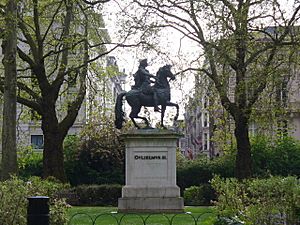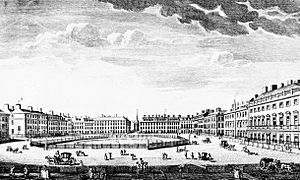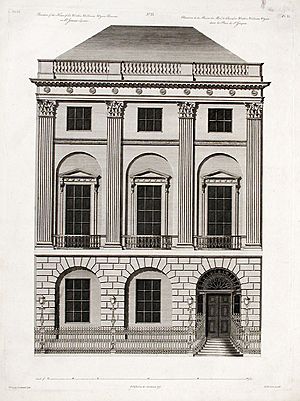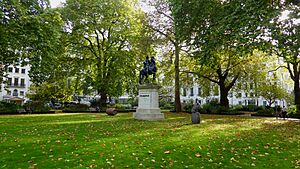St James's Square facts for kids
Quick facts for kids St James's Square |
|
|---|---|

The statue of William III by John Bacon at the centre of the square
|
|
| Location | St James's, London |
| Open | 10am – 4:30pm daily |
St James's Square is a famous garden square located in the St James's area of London. It's the only square of its kind in this part of the City of Westminster. Many of the buildings around the square have a classic Georgian or Neo-Georgian style.
For about 200 years, St James's Square was one of London's most fashionable places to live. Today, it's home to the main offices of well-known companies like BP and Rio Tinto Group. You'll also find several private members' clubs here, such as the East India Club and the Naval and Military Club. The High Commission of Cyprus, the London Library, and the global think tank Chatham House are also located here.
A key feature in the middle of the square is a tall, stone statue of William III. This statue, showing him on horseback, was put up in 1808.
Contents
History of St James's Square
In 1662, King Charles II allowed Henry Jermyn, 1st Earl of St Albans, to develop a large area of land. The Earl wanted to create a new, fancy neighborhood. He asked the King to let people buy the houses outright, not just rent them. In 1665, the King agreed, giving the Earl the full ownership of the land where St James's Square now stands.
This location was perfect because it was close to the royal palaces of Whitehall and St James. Houses on the east, north, and west sides of the square were built quickly. Each house was built separately, which was common back then.
Life in the Square in the 1700s
By the 1720s, many important people lived in St James's Square. Seven dukes and seven earls called it home! The houses on the east, north, and west sides were some of the most desired in London. They looked similar to other fancy houses, but they were special. They had wider windows, high ceilings, and deep plots of land. This allowed for very large and grand homes inside. Some houses even had beautiful interiors designed by famous architects like Matthew Brettingham and Robert Adam.
The southern side of the square was much simpler. The plots of land were smaller, and the houses originally faced Pall Mall. People living in these houses couldn't be part of the group that managed the square. They also couldn't use the central garden. There were ideas to buy these houses, tear them down, and open up the space to Pall Mall, but it never happened.
In 1727, a decorative pool and fountain were built in the center of the Square. However, the fountain plans were later dropped, and by the 1730s, water no longer flowed. The pool stayed until 1854. It was removed after residents complained during a cholera outbreak.
Changes Over Time
Things started to change around the 1830s. More clubhouses began to appear in the square. By 1844, people noticed that the square was becoming less fashionable. Wealthy residents started moving to other areas like Belgravia. By 1857, St James's Square had a bank, an insurance company, government offices, the London Library, and several clubs. However, some wealthy families continued to live there well into the 1900s.
A Sad Event in 1984
The Libyan embassy in St James's Square was the site of a serious incident in 1984. During a protest outside the building, shots were fired from inside. A police officer, Yvonne Fletcher, was sadly killed, and several demonstrators were injured. This event was a very sad moment in London's history.
Notable Buildings in St James's Square
The buildings around St James's Square are numbered starting from Number 1 on the eastern side. The numbers go around the square in an anti-clockwise direction up to Number 21.
- No. 1: This is the main office for BP, a major energy company. It's a modern building that still looks like the older Georgian style.
- No. 4: This building houses the Naval and Military Club. It's a Georgian house built between 1726 and 1728. Famous people like Nancy Astor once lived here. It's the only house in the square that still has its large original garden.
- No. 5: This building was once the Libyan "People's Bureau." It was the site of the sad 1984 incident where shots were fired, leading to the death of police officer Yvonne Fletcher.
- No. 6: This is the main office for Rio Tinto Group, a large mining company. The original building here was home to the Hervey family for almost 300 years.
- Nos. 9 to 11: These buildings were constructed in the 1730s. Number 10 is now Chatham House, a well-known international affairs think tank. It was once home to three British Prime Ministers: William Pitt the Elder, Earl of Derby, and William Ewart Gladstone.
- No. 12: Built in 1836, this was once the home of Ada Lovelace, a very important figure in early computer science.
- No. 13: This building is now the High Commission of the Republic of Cyprus.
- No. 14: The London Library has been located here since 1845. It's a very important library.
- No. 15: Known as Lichfield House, this building was designed in 1764. It's now used as offices.
- No. 16 and 17: These buildings are now part of the East India Club.
- No. 19: This building is the UK headquarters for Rolex, the famous watch company.
- No. 20/21: The design for No. 20 by Robert Adam is highly praised. It was later expanded to include No. 21.
- No. 31: This was once Norfolk House, the London home of the Dukes of Norfolk. The original building was taken down in 1938. A new building with the same name was built. During World War II, this new Norfolk House was the headquarters for U.S. General Dwight D. Eisenhower. Important plans for D-Day (Operation Overlord) were made here.
The Gardens of St James's Square
| Saint James' Square (Rates) Act 1725 | |
|---|---|
| Act of Parliament | |

|
|
| Long title | An Act to enable the present and future Inhabitants of the East, North, and West Sides, or Lines, of St. James's Square, to make a Rate on themselves, for raising Money sufficient to clean, adorn, and beautify the said Square, and to continue the same in Repair. |
| Citation | 12 Geo. 1. c. 25 |
| Dates | |
| Royal assent | 26 April 1726 |
The lovely gardens in the center of St James's Square are looked after by the St James's Square Trust. This Trust gets its money from the owners of the buildings around the square. It was set up by a special law called the Saint James' Square (Rates) Act 1725. This law allowed the property owners to collect money from themselves to "clean, adorn, and beautify" the square. This was the very first law passed to manage a London square, and it's still in use today!
The gardens are usually open to the public on weekdays from 7:30 AM to 4:30 PM. At other times, they are locked and only accessible to the property owners and residents. Sometimes, the gardens are used for art shows, weddings, and other events.
Getting There
- The postcode for St James's Square is SW1Y.
- The closest Tube stations are Piccadilly Circus and Green Park.
See also
 In Spanish: St. James Square para niños
In Spanish: St. James Square para niños






